User Opinions
|
||||||||||
|
|
|
| Tue Jul 24, 2007 - 10:30 AM EDT - By Harv Laser | |
|
|
|
|
|||||||||||
Note: Click on most pics to open full view.
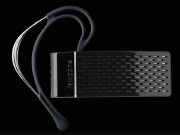
The Aliph Jawbone Noise Shield Bluetooth Headset (hereafter just the "Jawbone") is one of the most innovative and fascinating accessories I've had hanging off my ear in quite a while. It's a melding of high art and high technology, and while it looks like no other Bluetooth headset I've ever seen, and operates differently than most, it isn't without its quirks, so let's explore this piece of wearable art.
Before I get started, though, you'll notice two TreoCentral store "Buy" buttons over on the right � the store stocks the Jawbone in two colors: gray, black, and red. They are mechanically, electronically, and functionally identical. The reason the black and red versions are 20% costlier is because they're in shorter supply and harder to source, so if you absolutely have to have it in black or red, you'll pay a premium for that decision.
Regular readers will know I don't have much of a love affair with Bluetooth headsets. Although there are hundreds of them, the dozen or so that I've tested and reviewed generally didn't live up to their mfrs.' hype � either they were uncomfortable, had so many tiny buttons on them that I could never remember which did what, were hellatiously complicated to operate, wouldn't stay on or in my ear(s), (I wear glasses and the glasses' earpiece often affects how a headset will or won't fit me).. or they had such huge flashing blue lights on them that they reflected off the inside of my glasses' lenses, and made me look like a Borg. I don't want to look like a Borg, thank you.
Further, the well-known Bluetooth spec's claimed 10 meter (33 feet) range is, in my experience, completely bogus for voice use � transmitting data that far, sure, it can manage it, but I have yet to meet a Bluetooth headset whose sound didn't break up into snap, crackle, and fizz when I walked more than ten feet away from the Treo, regardless of model, to which it was paired. So they might be all the rage, but me, if I have my druthers, I'd druther use a high quality wired headset if I'm in a situation where I have to use a headset at all.
Nevertheless, always on a quest to road test something new, innovative, and if it comes along for the ride, stylish, the Jawbone looked like just the ticket.

The Jawbone's design sprang from the talented mind of Yves Behar's Fuse Project studios (and you owe it to yourself to take a look at that company's Flash-driven Web site, it is truly stunning in a very modern "high art" way).. the Jawbone looks like no other headset, and works like no other headset, at least none with which I have any experience.
Upon opening the plain, white shipping box, I was greeted by an absolutely gorgeous Lucite display case that looks for all the world like a miniature version of the kind of floor-standing display you'd find a valuable sculpture or antiquity nestled in at an upscale art gallery or museum; a truly impressive piece of packaging design.
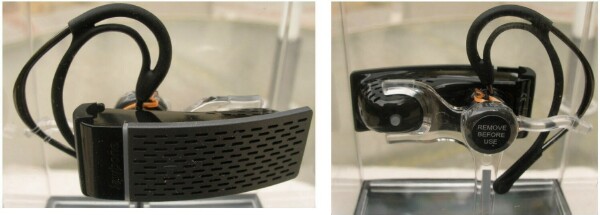
With both a tiny rubber band and clear plastic strap, the Jawbone is fastened to, and cradled atop and into an ingeniously designed, multi-forked, rubber-cushioned clear pedestal and base, below which are two small, black cardboard boxes holding its accessories. The sensual, unusual, "perforated" curve of the Jawbone's design sharply contrasts with the "nothing but right angles" clear and black packaging. This ultra-clean, futuristic presentation really makes your standard electronic accessory package look like something out of a 1950s Woolworth's. It's a thing of beauty just to hold and look at.

Although a box does not a product make, it is one damn impressive piece of packaging � obviously the work of very talented designers. So I held it, and studied it, and shot some pictures for you before removing the Jawbone from the embrace of its clear cradle, which was no easy feat, as I was literally afraid of breaking something as I studied it some more to try to figure out how to get it outta there.
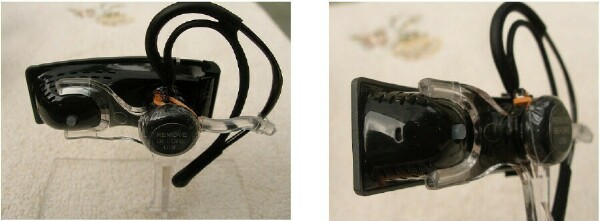
Aliph has packed a very well-written and copiously illustrated 30 page, pocket-sized manual with the headset. Although the Jawbone is made in China (these days, what isn't?..), the manual didn�t read like the typical "Chinglish" mangled translation we've all seen way too many times.
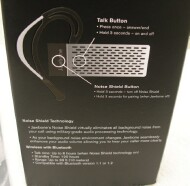
The Jawbone only has two control buttons, which serve different purposes depending on how many times you tap them, or hold them down.
With the Jawbone in one hand and the booklet in the other, I pressed the headset's "on" button, which is actually just a tiny raised bump on the sensuously curved faceplate � the entire faceplate IS a button. Nothing happened. Odd, since most small electronics with sealed-in batteries usually come with at least a partial charge on them. No, it wasn't broken, the Jawbone, at least this one, shipped with a completely discharged battery. So step number one was to fully charge it up.
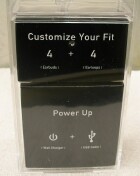
The bottom of the two included small black boxes contains an AC wall wart with a standard USB plug on it, and a USB cable with a standard plug on one end, and a radically NON-standard connector on the other. Why they chose to go this route, rather than just using a mini-USB connector on the headset end is a mystery. Art for art's sake? Who knows. But one possibly unintended side effect of this strange connector is that if you, like me, have mountains of electronics and cables all over the place, you'll NEVER look at this one and wonders what piece of gear it belongs to. That peculiar "other end" of the cable fits onto the Jawbone and ONLY the Jawbone. So let's plug it in and give it a full charge.. but wait.. there's a tiny black rubber cap on the Jawbone's power connector you have to remove first to expose the Gold power contacts. And no, the rubber cap isn't hinged, so if you ever need to put it back on for some reason, better remember where you put it.
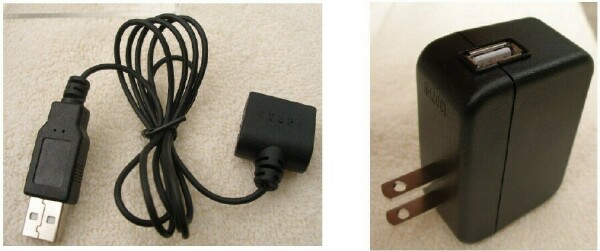

Between the perforated faceplate and the other (shiny black plastic) control button which has a raised logo on it so you can operate it by touch, runs a narrow, full-width LED. This light has different modes and comes on steady or flashes at different speeds, sometimes red, sometimes white, and sometimes alternating between the two, as a visual indicator of what the headset is trying to tell you it's up to. This is all nicely explained in the manual.
I connected the AC charger to an outlet, hooked it to the Jawbone with the included cable (you can also eschew the wall wart and cable the Jawbone directly to your powered-on laptop to charge it), and waited for the charging light to change from solid red (charging) to solid white (fully charged). And waited. And waited some more. It took three and a half hours to fully charge the Jawbone the first time, although the manual said "about two hours." Aliph, please ship this baby with at least a partial charge on the battery, eh?
Well, while sitting around waiting for it to finish charging, I read through the manual a few times to familiarize myself with the next step � how to pair and use the thing, and its various features.
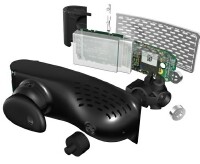
The Jawbone motto plastered on the packaging is "Noise is Nothing" � to that lofty end, it has both built in noise reduction and adaptive earpiece speaker amplification. Buzzword city.. What's it mean? It means it uses a combination of a dual-array mic and sophisticated internal electronics to discriminate between your voice and surrounding ambient noise, the goal being, of course, that whomever you're talking to on a call hears only your voice and not the outside world, AND, that it automatically raises earpiece volume on YOUR end of a call if you move in and out of Noiseville, although you can adjust the incoming volume manually too (more on that later)..
There's a video demo on Jawbone's site that demonstrates these capabilities. The site states "there have been no modifications to the sound quality" next to the window in which the demo plays, although you always have to wonder if these kind of demos weren't cooked or tweaked a bit for the best possible results � after all, no mfr. is going to present this kind of demo except to flatter and promote their product in the best possible way, but we'll have to take them at their word. Check it out for yourself. Dieter Bohn of WMExperts (TreoCentral's sister site for Windows Mobile) has also done a video review, which you can find here.
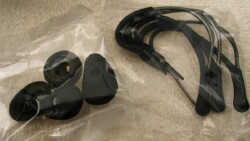
So, Jawbone unpacked, charged up, manual studied, it was time to actually USE the thing. The next step was fitting it to my noggin and my ear for the most comfortable, satisfying results. The Jawbone comes with four combination metal and rubber ear loops, and five earbuds. Some people like to wear headsets on their left ear (like me), some on their right. People have different size ears and ear canals. Aliph has tried to accommodate everyone. Out of the box, the Jawbone has a right ear loop mounted to it. Not my style, so I ripped into the plastic baggie and fished out a left ear loop, carefully extracted the former, and inserted the latter.
Unlike many other headsets, you do NOT bend and shape and mold these earloops to the contours of your earlobe. In fact, you can't. The rubber part is for comfort, the metal part is for rigidity. Each earloop terminates in a half inch long thin metal tip that you ease into a keyed hole in the Jawbone's body. This hole is internally spring-loaded because in order for its electronic noise reduction scheme to work, AT ALL, a tiny white rubber nub on the face side of the headset has to lightly touch your cheek.
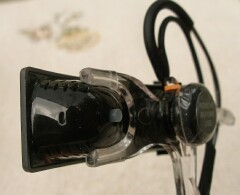
In doing so, through the magic of its circuitry, it discriminates between your voice coming out of your head with surrounding ambient noise of the world around you. So the spring-loaded earloop keeps the Jawbone VERY lightly pressed against your cheek. Touch your cheek as lightly as you possibly can with a fingertip.. that's what it feels like; it's barely noticeable. Don't mistake this for a "bone conduction" headset which is an entirely different kind of beast.
Next, an earbud to best fit your ear and you get five from which to choose.. each one is a soft rubber cap over a twist-on twist-off plastic shell with a 1/8" hole in it that lines up with the earpiece hole on the headset. The out-of-the-box pre-mounted round one didn't want to stay in my ear at all, so I tried the others one by one and settled on an earbud with an sort of bent oval / elliptical shape and got wonderful fit from it. Since these earbuds are more than just a lump of rubber and they literally twist 90 degrees and LOCK onto the Jawbone, you don't have to worry about having one fall off when you remove the headset.
Putting ON the Jawbone takes a bit of practice too. Since the earloops have no "give" to speak of, you either have to use the two-handed method and kind of wiggle your earlobe under it, or, with some practice, you can turn the headset forward, and slide it on over your ear in a turning motion so that the earloop's tip glides down over the top of your ear and ends up wrapped around the earlobe. Again, as a glasses wearer, I felt my spectacles' earpiece interfered a bit with the Jawbone's earloop's intended fit. Your mileage may vary depending on if you wear glasses or not, and what kind you wear.
Pairing the Jawbone with the Treo is pretty much like any other Bluetooth headset. Before putting it on your head, press down on the black shiny button, the one with the raised logo and the LED goes into an alternating red / white flashing sequence. This is "Bluetooth discovery" mode. Let your Treo discover it, pair it with the standard, easy-to-remember "0000" Passcode, and you're ready to go.
The Jawbone's noise reduction circuitry is automatically turned ON every time the headset is powered up. Using that black button, you can turn it off if you want to, although in my tests on a few calls, my callers said it sounded awful with it turned off � I made some calls with my air conditioner blasting feet away from me and the TV cranked up. As long as the Jawbone's adaptive noise shield was ON and that little rubber nub was touching my cheek, my friends said they could hear very faint sounds way off in the background but really couldn't tell what they were.
A three-second press of the black button to turn OFF the noise reduction, and they told me they could clearly hear the a / c's fan blowing, and could hear the TV totally overpowering my voice. So Aliph's circuitry DOES do what it claims to do and what those two demos show it doing.
However, noise reduction is not 100%. Talking to the same people, on the same calls, I turned the Jawbone off, and jacked in UmeVoice's theBoom"O" (my favorite wired headset of all time), and ALL callers told me They heard an obvious, distinct difference between theBoom's noise reduction, which is handled by their brilliant, totally mechanical, "acoustic wave-shaping", rather than the Jawbone's electronic scheme.
Wearing the "O", I could, as UmeVoice proclaims and demonstrates on THEIR site "Whisper and be heard." Although I've been using their fabulous headsets for about a year, I can say with complete conviction that the noise-reduction sound demos on theBoom site are absolutely NOT cooked or tweaked in any way.
So I'll give the Jawbone props for doing what it claims to do � massively reduce ambient noise so your callers can hear you and not the noisy world around you, and automatically raise and lower the earpiece volume as you move into and out of noisy areas. The Jawbone's black button manually raises the earpiece volume in six steps � a light tap on it during a call bumps it up a notch (with an accompanying beep) until you reach the highest level, and then, as if going around in a circle, the next tap takes it down to the lowest level again. Most headset mfrs. use two volume buttons rather than this approach, but again, it's a fair-sized button and cycling up through volume levels by tapping it seems just as easy to me as fingering around for a pair of tiny up / down buttons does.
My main gripe with the Jawbone's sound is that I found what I heard coming from the earpiece, even after I found the best earbud to fit me, has basically NO bass at all. Everyone sounded tinny to me. All treble, some high midrange, but no mid or low bass at all and I mean NONE.
Aliph publishes no frequency response specs for the earpiece at all � I suspect here, they cheaped out on this otherwise beautiful piece of hardware. Again, I have to draw a comparison the hardwired theBoom "O" � its comfortable, padded earpiece has FAR wider frequency response, and human voices sound human, not like they're coming out of a child's toy telephone with a two cent speaker, which is the best analogy I can think of for how the Jawbone's earpiece sounded to me.
My other gripe is that in spite of its absolutely gorgeous packaging, Aliph includes NO little carrying case or pouch to hold the Jawbone when you have it with you but you're not wearing it. For a hundred bucks or more, I don't think it would have put them out of business to toss in a little vinyl drawstring bag to protect it. You're certainly not going to take the fancy plastic pedestal and Lucite box with you everywhere you go, so you'll just have to plop it into a pocket or purse.
In prepping for this review, I wore the Jawbone for a couple hours at a stretch and didn't find it got painful or all that annoying. It only weighs half an ounce and once I settled on the right earloop and earbud to make it comfy for ME, it was very comfortable.. but if I was one of those on-the-go business types who DO wear a Bluetooth headset literally all day, it probably would get a bit irritating.
Lastly, neither of the Jawbone's function buttons do anything unless the headset is powered on and you're on a call. You can't raise or lower the volume until you're connected. You can't turn noise reduction on or off until you're connected. And like all Bluetooth headsets that have a sequence of flashing lights accompanied by different sequences of beeps, you can either see the lights or put the headset on and hear the beeps but unless you're watching yourself in a mirror, you can't do both at once, but that's just the nature of the beast, and not unique to the Jawbone in any way.
Copyright 1999-2016 TreoCentral. All rights reserved :
Terms of Use : Privacy Policy
TREO and TreoCentral are trademarks or registered trademarks of palm, Inc. in the United States and other countries;
the TreoCentral mark and domain name are used under license from palm, Inc.
The views expressed on this website are solely those of the proprietor, or
contributors to the site, and do not necessarily reflect the views of palm, Inc.
Read Merciful by Casey Adolfsson